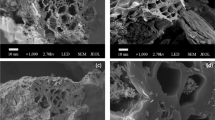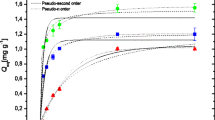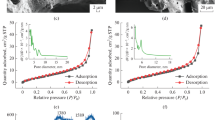Abstract
Modified biochar is an efficient and economical adsorbent material that is widely used for the removal of heavy metals from polluted water bodies. In this study, eucalyptus biochar was synthesized via pyrolysis as a precursor to carbon and modified by potassium permanganate (KBC) to enhance its adsorption properties for Cd removal. The physicochemical properties of KBC were comprehensively characterized and analyzed by various characterization techniques. The effects of experimental parameters such as adsorbent dosage, pH, adsorption time, initial concentration, and temperature on the adsorption capacity and removal rate of Cd(II) were evaluated. The mechanism of Cd(II) removal by KBC was also explored using adsorption kinetics, isotherms, and thermodynamics. The results showed that the sorption capacity obtained with KBC for Cd(II) was 31.05 mg·g−1 that is better than that of BC (26.438 mg·g−1), and its removal rate was 99.36% under the optimal conditions (pH 5, dosage 80.0 mg, contact time 6 h, temperature 25 °C, and initial concentration 50.0 mg·L−1. The adsorption process follows the pseudo-second-order kinetic model and the Langmuir isothermal adsorption model based on monolayer adsorption on a homogeneous surface with spontaneous heat absorption under the combined physical and chemical effects. The adsorption mechanism of Cd(II) is mainly the KBC oxygen-containing and manganese-containing groups through complexation, oxidation, and cation-π electron interaction. It is illustrated that potassium permanganate’s surface modification of eucalyptus biochar is an effective method to treat the heavy metal contaminated environment.






Similar content being viewed by others
Data availability
Not applicable.
Change history
30 November 2021
A Correction to this paper has been published: https://doi.org/10.1007/s13399-021-02126-0
References
Chen XC, Chen GC, Chen LG, Chen YX, Johannes L, Murray BM, Anthony GH (2011) Adsorption of copper and zinc by biochars produced from pyrolysis of hardwood and corn straw in aqueous solution [J]. Bioresour Technol 102(19):8877–8884. https://doi.org/10.1016/j.biortech.2011.06.078
Chen Z, Xiao X, Chen B, Zhu L (2015) Quantification of the chemical states, dissociation constants and contents of oxygen-containing groups on the surface of biochars produced at different temperatures. Environmental Science & Technology: ES&T 49(1):309–317. https://doi.org/10.1021/es5043468
Du Q, Sun J, Li Y, Yang X, Wang X, Wang Z, Xia L (2014) Highly enhanced adsorption of congo red onto graphene oxide/chitosan fibers by wet-chemical etching off silica nanoparticles. Chem Eng J 245:99–106. https://doi.org/10.1016/j.cej.2014.02.006
Faheem, Yu H, Liu J, Shen J, Sun X, Li J, Wang L (2016) Preparation of MnO x -loaded biochar for Pb 2+ removal: adsorption performance and possible mechanism. J Taiwan Inst Chem Eng 66:313–320. https://doi.org/10.1016/j.jtice.2016.07.010
Feng J, Zou L, Wang Y, Li B, He X, Fan Z, Ren Y, Lv Y, Zhang M, Chen D (2015) Synthesis of high surface area, mesoporous MgO nanosheets with excellent adsorption capability for Ni(II) via a distillation treating. J Colloid Interface Sci 438:259–267. https://doi.org/10.1016/j.jcis.2014.10.004
Goretti E, Pallottini M, Ricciarini MI, Selvaggi R, Cappelletti D (2016) Heavy metals bioaccumulation in selected tissues of red swamp crayfish: an easy tool for monitoring environmental contamination levels. Sci Total Environ 559:339–346. https://doi.org/10.1016/j.scitotenv.2016.03.169
Guishan H, Xiong L, Lingdi S, Min W, Ce W, Xufeng Y, Xuefen W (2015) High recovery of lead ions from aminated polyacrylonitrile nanofibrous affinity membranes with micro/nanostructure. J Hazard Mater 295:161–169. https://doi.org/10.1016/j.jhazmat.2015.04.020
Izadi A, Mohebbi A, Amiri M, Izadi N (2017) Removal of iron ions from industrial copper raffinate and electrowinning electrolyte solutions by chemical precipitation and ion exchange. Miner Eng 113:23–35. https://doi.org/10.1016/j.mineng.2017.07.018
John GO, Sara JC, Graeme JM (2018) Enhanced removal of high Mn(II) and minor heavy metals from acid mine drainage using tunnelled manganese oxides. J Environ Chem Eng 6(2):3249–3261. https://doi.org/10.1016/j.jece.2018.04.063
Li L, Shisuo F (2018) Removal of cadmium in aqueous solution using wheat straw biochar: effect of minerals and mechanism. Environ Sci Pollut Res Int 25(9):8688–8700. https://doi.org/10.1007/s11356-017-1189-2
Liang J, Li X, Yu Z, Zeng G, Luo Y, Jiang L, Yang Z, Qian Y, Wu H (2017) Amorphous MnO2 modified biochar derived from aerobically composted swine manure for adsorption of Pb(II) and Cd(II). ACS Sustain Chem Eng 5(6):5049–5058. https://doi.org/10.1021/acssuschemeng.7b00434
Lina RA, Stéphan RG, Stéphane Z, Serge S (2021) Nanoplastics adsorption and removal efficiency by granular activated carbon used in drinking water treatment process. Sci Total Enviro 791:148175. https://doi.org/10.1016/j.scitotenv.2021.148175
Liu Y, Wei J, Cai W, Li Z, Zhou J, Han B (2019) Preparation of amino-functionalized magnetic biochar with excellent adsorption performance for Cr(VI) by a mild one-step hydrothermal method from the peanut hull. Colloids and Surfaces, A Physicochemical and Engineering Aspects 563:102–111. https://doi.org/10.1016/j.colsurfa.2018.11.062
Liu LH, Yue TT, Liu R, Lin H, Wang DQ, Li BX (2021) Efficient adsorptive removal of Cd(II) in an aqueous solution by biochar derived from sewage sludge and calcium sulfate. Bioresour Technol 336:125333. https://doi.org/10.1016/j.biortech.2021.125333
Lu Z, Zhang H, Shahab A, Zhang K, Zeng H, Bacha A-U-R, Nabi I, Ullah H (2021) Comparative study on characterization and adsorption properties of phosphoric acid activated biochar and nitrogen-containing modified biochar employing Eucalyptus as a precursor. J Clean Prod:303. https://doi.org/10.1016/j.jclepro.2021.127046
Ma Y, Liu W-J, Zhang N, Li Y-S, Jiang H, Sheng G-P (2014) Polyethylenimine modified biochar adsorbent for hexavalent chromium removal from the aqueous solution. Bioresour Technol 169:403–408. https://doi.org/10.1016/j.biortech.2014.07.014
Mohan D, Pittman CU, Bricka M (2007) Sorption of arsenic, cadmium, and lead by chars produced from fast pyrolysis of wood and bark during bio-oil production [J]. J Colloid Interface Sci 310(1):57–73. https://doi.org/10.1016/j.jcis.01.020
Nie R, Miao M, Du W, Shi J, Liu Y, Hou Z (2016) Selective hydrogenation of CC bond over N-doped reduced graphene oxides supported Pd catalyst. Appl Catal B Environ 180:607–613. https://doi.org/10.1016/j.apcatb.2015.07.015
Puppa LD, Komárek M, Bordas F, Bollinger J-C, Joussein E (2013) Adsorption of copper, cadmium, lead and zinc onto a synthetic manganese oxide. J Colloid Interface Sci 399:99–106. https://doi.org/10.1016/j.jcis.2013.02.029
Qu SWN, He F, Wang M, Liu G, He, a.H. (2015) Tea waste-supported hydrated manganese dioxide (HMO) for enhanced removal of typical toxic metal ions from water. RSC Adv. https://doi.org/10.1039/c5ra16556c
S, V., J, L. (2012) Effect of alternating and direct current in an electrocoagulation process on the removal of cadmium from water. Water Sci Technol J Int Assoc Water Pollut Res 65(2):353–360. https://doi.org/10.2166/wst.2012.859
Salleh JM, Nor AB, Othman MZ (2012) Synthesis and characterization of superfine nanostructure manganese dioxide spontaneously coated onto carbon nanotubes. Adv Mater Res 1529:398–401. https://doi.org/10.4028/www.scientific.net/AMR.364.398
Samsuri AW, Sadegh-Zadeh F, Seh-Bardan BJ (2013) Adsorption of As(III) and As(V) by Fe coated biochars and biochars produced from empty fruit bunch and rice husk [J]. J Environ Chem Eng 1(4):981–988. https://doi.org/10.1016/j.jece.2013.08.009
Satarug S, Vesey DA, Gobe GC (2017) Current health risk assessment practice for dietary cadmium: data from different countries. Food Chem Toxicol 106:430–445. https://doi.org/10.1016/j.fct.2017.06.013
Sefiu OA, Temesgen GK, Simiso D, Mathew MN (2021) Ball-milling synthesis of biochar and biochar–based nanocomposites and prospects for removal of emerging contaminants: A review. J Water Process Eng 41:101993. https://doi.org/10.1016/j.jwpe.2021.101993
Shi Q, Zhang H, Shahab A, Zeng H, Zeng H, Nabi I et al (2021) Efficient performance of magnesium oxide loaded biochar for the significant removal of Pb2+ and Cd2+ from aqueous solution. Ecotoxicol Environ Saf 221:112426
Sirviö JA, Visanko M (2020_ Lignin-rich sulfated wood nanofibers as high-performing adsorbents for the removal of lead and copper from water. J Hazard Mater, 383. https://doi.org/10.1016/j.jhazmat.2019.121174
Song Z, Lian F, Yu Z, Zhu L, Xing B, Qiu W (2014) Synthesis and characterization of a novel MnO x -loaded biochar and its adsorption properties for Cu2+ in the aqueous solution. Chem Eng J 242:36–42. https://doi.org/10.1016/j.cej.2013.12.061
Su H, Fang Z, Tsang PE, Fang J, Zhao D (2016) Stabilisation of nanoscale zero-valent iron with biochar for enhanced transport and in-situ remediation of hexavalent chromium in soil. Environ Pollut 214:94–100. https://doi.org/10.1016/j.envpol.2016.03.072
Sun C, Chen T, Huang Q, Wang J, Lu S, Yan J (2019) Enhanced adsorption for Pb(II) and Cd(II) of magnetic rice husk biochar by KMnO4 modification. Environ Sci Pollut Res 26(9):8902–8913. https://doi.org/10.1007/s11356-019-04321-z
Tan X-f, Liu Y-g, Gu Y-l, Xu Y, Zeng G-m, Hu X-j, Liu S-b, Wang X, Liu S-m, Li J (2016) Biochar-based nano-composites for the decontamination of wastewater: a review. Bioresour Technol 212:318–333. https://doi.org/10.1016/j.biortech.2016.04.093
Wang MC, Sheng GD, Qiu YP (2015) A novel manganese-oxide/biochar composite for efficient removal of lead(II) from aqueous solutions. Int J Environ Sci Technol 12(5):1719–1726. https://doi.org/10.1007/s13762-014-0538-7
Wang, H.-Y., Chen, P., Zhu, Y.-G., Cen, K., Sun, G.-X. 2019. Simultaneous adsorption and immobilization of As and Cd by birnessite-loaded biochar in water and soil. Springer Berlin Heidelberg, 26(9), 8575-8584. https://doi.org/10.1007/s11356-019-04315-x
Wu JW, Wang T, Wang JW, Zhang YS, Pan WP (2021) A novel modified method for the efficient removal of Pb and Cd from wastewater by biochar: enhanced the ion exchange and precipitation capacity. Sci Total Environ 754:142150. https://doi.org/10.1016/j.scitotenv.2020.142150
Xue FT, Shi SZ, Ru PW, Yi DC, Pau LS, Feng FZ, Shih HH (2021) Role of biochar surface characteristics in the adsorption of aromatic compounds: Pore structure and functional groups.Chinese Chemical Letters. https://doi.org/10.1016/j.cclet.2021.04.059
Yang X, Yang Y, Wan YY, Wu RJ, Feng DK, Li K (2021) Source identification and comprehensive apportionment of the accumulation of soil heavy metals by integrating pollution landscapes, pathways, and receptors[J]. Sci Total Environ 786:147436. https://doi.org/10.1016/j.scitotenv.2021.147436
Zeng H, Zeng H, Zhang H, Shahab A, Zhang K, Lu Y et al (2021) Efficient adsorption of Cr (VI) from aqueous environments by phosphoric acid activated eucalyptus biochar. J Clean Prod 286:124964
Zhang J, Lü F, Shao L, He P (2014) The use of biochar-amended composting to improve the humification and degradation of sewage sludge. Bioresour Technol 168:252–258. https://doi.org/10.1016/j.biortech.2014.02.080
Zhang C, Yu Z, Zeng G, Huang B, Dong H, Huang J, Yang Z, Wei J, Hu L, Zhang Q (2016) Phase transformation of crystalline iron oxides and their adsorption abilities for Pb and Cd. Chem Eng J 284:247–259. https://doi.org/10.1016/j.cej.2015.08.096
Zhu S, Khan MA, Wang F, Bano Z, Xia M (2020) Rapid removal of toxic metals Cu2+ and Pb2+ by amino trimethylene phosphonic acid intercalated layered double hydroxide: A combined experimental and DFT study. Chem Eng J, 392. https://doi.org/10.1016/j.cej.2019.123711
Funding
The authors would like to thank the financial support of the Guangxi Innovation Research Team Project (2018GXNSFGA281001).
Author information
Authors and Affiliations
Contributions
All authors contributed to this study. All authors read and approved the final manuscript.
Zhenlin Mo: writing—original draft preparation
Qingliang Shi: methodology
Honghu Zeng: formal analysis and investigation
Ze Lu: conceptualization, methodology
Jianhong Bi: writing—review and editing
Hua Zhang: writing—review and editing, funding acquisition
Jörg Rinklebe: review and editing
Eder C. Lima: review and editing
Audil Rashid: review and editing
Asfandyar Shahab: writing—review and editing
Corresponding authors
Ethics declarations
Conflict of interest
The authors declare no competing interests.
Additional information
Publisher’s note
Springer Nature remains neutral with regard to jurisdictional claims in published maps and institutional affiliations.
The original online version of this article was revised: The 2nd affiliation for Jörg Rinklebe was missing.
Rights and permissions
About this article
Cite this article
Mo, Z., Shi, Q., Zeng, H. et al. Efficient removal of Cd(II) from aqueous environment by potassium permanganate-modified eucalyptus biochar. Biomass Conv. Bioref. 14, 77–89 (2024). https://doi.org/10.1007/s13399-021-02079-4
Received:
Revised:
Accepted:
Published:
Issue Date:
DOI: https://doi.org/10.1007/s13399-021-02079-4




